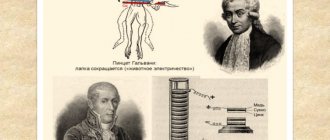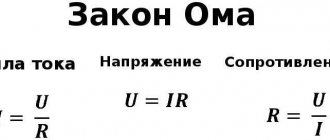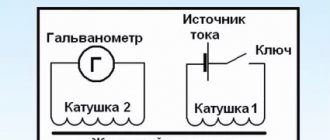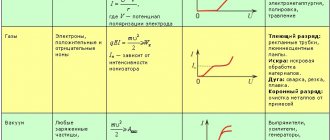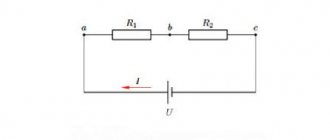During electrification, the law of conservation of charge is satisfied. It was formulated and confirmed experimentally in 1843 by Michael Faraday, an English chemist and experimental physicist. This law holds true for any closed system.
Note: For a system of charges to be closed, additional charges from the outside must not penetrate into it, and charges belonging to this system must not leave it.
Let's formulate the law in words
Two electrically neutral bodies can be electrified by friction. During their electrification, charges are redistributed between bodies. A small portion of electrons transfers from one body to another. New particles do not appear, and existing ones do not disappear.
The sum of charges in a closed system does not change.
Theory
Let's do a simple experiment.
Let's install a couple of electrometers on the table at a distance. We attach a flat metal object (disk, plate) to the rod of the first one. Lay a layer of thin insulator on top: a couple of sheets of paper, cloth. Place a second metal object with a handle made of insulating material on top. Let's take the handle of the upper disk and rub it against the insulator, then lift the object. The arrow will deviate to the side - evidence of the appearance of a charge on the disk with the rod. Let's bring this object to the rod of the second electrometer. The arrow will deviate approximately at the same angle. It turns out: due to electrification, charges when the bodies touch simultaneously appear on both.
The last step is to connect the rods with a metal object to a handle made of insulating material. The arrows of both devices return to their original places - the charges have neutralized each other - for the system it has become zero.
Similar experiments are carried out with any bodies capable of electrification. They show that objects acquire equal in magnitude and opposite charges - equal in modulus.
The formulation (definition) of the law of conservation of electric charge is as follows: the algebraic sum (modulo) of electric charges in a closed system, from where they do not leave or enter, remains a constant - an unchanged value. They can be transmitted between elements of the system in any way; charges are not capable of disappearing without a trace or appearing out of nowhere. We established this experimentally.
When a positive charge q+ - positron appears, a negative q- - electron is necessarily formed, equal to it in modulus or absolute value. They are also capable of neutralizing each other if they are absolutely equal in value, but opposite in value.
To master the material, formulate in your own words the law of conservation of electric charge.
The deviation of the electrometer needle is explained by the flow of elementary particles of electrons from one body to another. As a result, one becomes positively charged, the other negatively. When such bodies come into contact, excess (free) electrons from one flow to the other, filling the unoccupied electron shells in the atoms.
Formula for the law of conservation of charge
Let there be several charged particles in a closed system, for example, n pieces. We denote each particle by the letter \(q\) and number it.
Then, using the formula, the law of conservation of charge can be written as follows:
\[ \large \boxed {q_{1} + q_{2} + q_{3} + \ldots + q_{n}= const } \]
Charge is a scalar quantity; such quantities are added algebraically, each charge is written in a formula with its own sign.
Notes:
- Scalar quantities are ordinary positive and negative numbers.
- The quantity denoted in Latin by the word “constant” is unchanging, and “variant” is changing.
Formula for finding charge
The required value can be determined from the physical and mathematical formula for current strength. In accordance with it, you need to multiply the current strength by the time it passes through the conductor. The amount of charge can be found through the formula +-ne, where n is an integer and e is equal to the value = -1.6*10^-19 Coulomb.
Note ! The charge formula is a consequence of the direct dependence of the electromagnetic field strength on the potential of its particle, which is the basic rule for finding the capacity of a charged capacitor and the amount of energy accumulated in it. In addition, the amount of charge can be calculated using the Lorentz force.
Basic formulas
Closed system charging - example
Let's consider a system in which charged bodies are present (Fig. 1).
We can move these bodies across a certain region of space (system). Let the charges of the bodies be small enough so that Coulomb forces cannot independently move any of the bodies from their place.
Charges will act on each other, since in the space around each charge there is its own electric field.
Let us assume that at the initial moment of time, the charged bodies were in the position presented in Figure 1.
Rice. 1. Closed system of charges at the initial moment of time
Let's add up the charges, taking into account their signs, and get the total charge of all bodies present in the system:
\[ \large (+3q) + (-4q) + (+6q) + (-2q) + (-q) = +2q \]
So, the total charge of the system at time No. 1 is +2q.
Now let's move the bodies, and at the same time bring some of the bodies into contact. There will be a redistribution of charges between the bodies. Read more in a separate article about electrification by contact. The new position of the bodies and their charges are presented in Figure 2.
Rice. 2. Closed system of charges after some time
Let us now calculate the total charge of all bodies in the system:
\[ \large (+2q) + (-3q) + (-3q) + (-q) + (+7q) = +2q \]
The total charge of the system at time No. 2 has not changed and is equal to +2q, because the system is closed.
Charges can be redistributed between bodies, but if the system is closed, then the algebraic sum of charges will not change.
A number that does not change is denoted by mathematicians as “const”.
The total charge of a closed system of two bodies electrified by friction is zero. Because the law of conservation of charge is satisfied.
Note: When electrified by friction, the charges of two bodies are equal in magnitude and opposite in sign. This can be verified by conducting an experiment describing how the charges of rubbing bodies relate.
Millikan experience
This is Robert Millikan, an American experimental physicist. Since the atom contains mobile particles that are capable of interacting with similar particles inside other atoms, they are most likely the basis of electrical processes, if the latter are considered at the atomic level. Consequently, these particles have a certain property that allows them, during interaction and redistribution, to “carry” electricity with them - we can roughly say that electricity is, as it were, “sewn into them.”
⚡ Let's present the second assumption in the form of a chain of thoughts :
- electricity is something like a property of subatomic particles;
- inside an atom there are two different types of particles somewhat similar to each other in terms of their “electrical properties” - protons and electrons;
- These particles are mutually exclusive in their properties, since usually the atom is at rest;
- electrons are more mobile than protons, because protons are concentrated in the nucleus;
- then if you measure the amount of “electrical property” for an individual electron, the same will work for a proton.
Let's try to calculate this amount. Let us have a body below with an excess of electrons, and above a body with a lack of electrons. If bodies are combined into a single system, they will create a zone of mutual attraction - atoms with an excess of electrons will tend to “throw off” the excess in the direction where the deficiency predominates.
This creates a kind of kinetic flow , so another body placed between these bodies will also begin to move, from excess to deficiency. The body, however, needs to be small so that, firstly, it moves, and, secondly, it needs to be dense so that it does not create unnecessary problems with calculating the mass.
Drops of oil - what could be better? A droplet falling under normal conditions is subject to two forces: the gravitational force $m\vec{g}$ and the drag force of the medium $F_{C}$. In this case, the movement occurs downward under the influence of gravity. Using a special device, you can record the maximum speed of fall when the resistance force is compared with gravitational force.
The resultant force in this case is zero, and the body, as a result, falls uniformly, not in an accelerated state. This will allow you to calculate the weight and mass.
When a droplet begins to move under the influence of an electric force, it is interesting that the direction of movement changes: the electric force in our experiment exceeds the gravitational and aerodynamic ones. We can also wait until the resultant is zero, thereby determining the maximum rate of rise , which will allow us, in turn, to calculate how much electrical force acts on the droplet.
Electrical force differs in its “guts” from mechanical forces: for example, both gravitational force and electric force both act on an object without direct contact, conditionally at a distance, however, the electric force clearly does not act on mass, but is precisely determined by the amount body of "electrical properties". The greater the amount of "electrical property", the greater the electrical force - by analogy, the greater the mass, the faster the body is attracted to the Earth.
In general, the “electrical property” is as fundamental a unit as mass. A simple result: the “electrical property” of subatomic particles was called electric charge .
Millikan, measuring the electrical force for many oil drops in the experiment we described above, saw a stunning pattern. The numerical value charge always turned out to be a multiple of the same number. This fully fit into the understanding of the atomic structure of matter at that time: there could be no way that there could be $4.54$ electrons in a droplet—there were either $4$ or $5$.
The estimated number was as follows:
$$1.6\cdot10^{-19}$$
Properties of charges
Quantitatively, the energy transferred by particles is usually measured in coulombs (C). Charge is a certain fundamental quantity of nature. Physicists cannot say what it is. But they learned to explain their interactions and were able to figure out the properties of the phenomenon. They found that a charge creates an electric field around itself. When another particle falls under its influence, it begins to experience its influence. If you remove the second charge, the force of interaction will not change instantly.
This theory was put forward by experimenter Michael Faraday and he called it the rule of short range action. It turned out that the carrier experiences the action of an electric field, even if there is no other charged particle nearby, that is, it perceives electromagnetic waves.
In addition, scientists were able to discover the following properties inherent in the charge:
- There are only 2 types of charged particles - positive and negative.
- In nature, there is no predominance of positive or negative charges, and their total number is the same.
- During electrification, the process is accompanied not by the appearance of new carriers, but by their separation.
- The size of the minimum positive charge (proton) that was discovered is 1.6021892 * 10-19 C. This value is equal in modulus to the electron.
- It is invariant, that is, its value does not depend on the chosen reference system.
- The energy possessed by a charged particle can take on any discrete values.
The last property was proven by the Soviet physicist Ioffe at the beginning of the 20th century. He took 2 metal plates. He charged one of them negatively and the other positively. Between them I placed specks of zinc dust. As a result, the physicist observed their interaction with the prototype of a flat capacitor. Under the influence of an electric field and ultraviolet radiation, electrons flew out of the zinc, and the speed of the dust particles changed.
Measuring it, he saw that the charge of zinc dust particles changed by a strict amount. But he was unable to measure it due to the complex shape of the dust. Robert Millikan managed to calculate the value of elementary energy. Instead of zinc, he used droplets of oil. The scientist was able to calculate the force of air resistance, and then determine the value of the elementary charge. It amounted to: 4.803242±0.000014×10-10 units (if the value is measured in SGSE).
This is the smallest value that can be obtained in nature. The remaining quantities are formed by quantization, that is, the total charge is always equal to an integer number of elementary ones.
Coulomb's experiment
The law of interaction of charges was formulated and empirically confirmed by Coulomb in 1785. For this, the physicist designed a special device - a torsion balance. This device could measure small forces that arise when bodies are charged. Moreover, for convenience, he introduced a quantity - a point charge.
In essence, this is an idealization that allows us to clearly describe the field of a charged body. Such a charge is understood as an electrified object, the dimensions of which can be neglected. There are grounds to assume that all energy is concentrated at one point. The scientist’s device consisted of the following elements:
- silk thread;
- two metal balls;
- graduated scale;
- paper disk;
- rocker arms
The essence of the experiment was as follows. Having suspended a rocker arm on which 2 balls were attached to a thin thread, Pendant lowered this structure into a glass vessel. The thread was placed at half the depth of the container. Moreover, a scale was attached opposite the balls along the outer diameter of the vessel. He would then lower the charged ball and observe the reaction.
It consisted in turning the rocker arm by a certain amount. Thus, not only was a phenomenon discovered in which the fact of the existence in nature of elementary carriers of electric charges was discovered, but also the electrification of bodies upon their contact. The scientist, measuring the angle of rotation, formulated a law. He said that the force with which the interaction of two charged elementary charges occurs is directly proportional to the product of their absolute values and inversely proportional to the square of the distance between them.
In mathematical form, this statement is described by the following formula: F = k * (q1 * q2)/r2, where k is the proportionality coefficient. In the international system of units of measurement it is defined as k = ¼pE. Moreover, E is a scalar quantity equal to 8.85 * 10-12 F / m. It is called the electrical constant and is determined by the medium in which the interaction occurs.
Coulomb's experiment helped to establish the electromagnetic essence of the interaction of electric charges, to understand that a particle has energy that it can transmit and due to which the electrical interaction of bodies occurs. But it also became clear that if the system is isolated from external influences, it is in energy equilibrium, that is, the law of conservation of energy applies.
General information
In 1666, Isaac Newton discovered the law of universal gravitation. In his description he used forces called gravitational. Their actions were explained by the influence of astronomical objects. It was found that the magnitude of the force depends on the mass of the interacting bodies. But at the same time, scientists, conducting experiments, observed phenomena of attraction or repulsion of small bodies that were not related to gravity.
There was an assumption about the existence of a certain substance. It was put forward by Benjamin Franklin in 1749. It was in his works that the word “charge” first appeared. But long before this, in the 6th century, the ancient Greek scientist Thales was able to discover electrical interaction.
At that time, he was unable to explain the nature of the emerging forces and simply stated an experimental fact. The philosopher discovered that if you rub an amber stone on fur, it begins to attract light particles, such as dust particles. It was not until 1600 that Gilbert used the word “electricity,” which means “amber” in Greek, to describe the phenomenon.
60 years later, the German Otto von Guericke built a device called an electrostatic machine. It consisted of a metal stand inserted into a sulfur ball. With its help, he was able to learn that objects can not only attract, but also repel. Experiments conducted by the Frenchman Charles Dufay showed that there are 2 types of electricity. Franklin later explained this by the existence of two kinds of particles:
- positive;
- negative.
The sign was assigned conditionally to make it convenient to study the phenomenon. Experiments have shown that 2 equally charged elements repel each other, while opposite ones attract. The manifestation of certain properties by bodies, as it turned out, depends on the crystalline structure of the body. Scientists have found that it is based on interatomic interaction.
The particle that carries the properties of an element is the atom. It consists of protons and neutrons that form the nucleus. Electrons rotate around the latter in orbitals. An atom is considered to be positively charged, and an electron is considered to be negatively charged. Moreover, the magnitude of the charges of both signs is the same, that is, the body is in energy equilibrium.
Electric field energy of a capacitor
The energy of a charged capacitor is equal to the work of external forces that must be expended to charge the capacitor.
The electrical energy of a capacitor is concentrated in the space between the plates of the capacitor, that is, in the electric field, therefore it is called electric field energy . Formulas for calculating the electric field energy:
Since the electric field strength is directly proportional to the voltage, the energy of the electric field of the capacitor is proportional to the square of the strength.
Electric field energy density:
where \( V \) is the volume of space between the plates of the capacitor.
The energy density does not depend on the parameters of the capacitor, but is determined only by the electric field strength.
Dielectrics in an electric field
Dielectrics are substances that do not conduct electric current. Dielectrics are glass, porcelain, rubber, distilled water, and gases.
There are no free charges in dielectrics; all charges are bound. In a dielectric molecule, the total negative charge of the electrons is equal to the positive charge of the nucleus. There are polar and non-polar dielectrics.
In molecules of polar dielectrics, nuclei and electrons are located so that the centers of mass of positive and negative charges do not coincide and are at some distance from each other. That is, molecules represent dipoles regardless of the presence of an external electric field. In the absence of an external electric field, due to the thermal motion of molecules, the dipoles are located randomly, so the total field strength of all dielectric dipoles is zero.
If, in the absence of an external electric field, the centers of mass of positive and negative charges in a dielectric molecule coincide, then it is called non-polar. An example of such a dielectric is the hydrogen molecule. If such a dielectric is placed in an external electric field, then the directions of the force vectors acting on positive and negative charges will be opposite. As a result, the molecule is deformed and turns into a dipole. When a dielectric is introduced into an electric field, its polarization occurs.
Polarization of a dielectric is the process of displacement in opposite directions of unlike bound charges that make up the atoms and molecules of a substance in an electric field.
If the dielectric is non-polar, then a displacement of positive and negative charges occurs in its molecules. Surface bound charges will appear on the surface of the dielectric. These charges are called bound because they cannot move freely separately from each other.
Inside the dielectric, the total charge is zero, and on the surfaces the charges are not compensated and create a field inside the dielectric, the intensity vector of which is directed opposite to the external field strength vector. This means that inside the dielectric the field has a lower intensity than in a vacuum.
A physical quantity equal to the ratio of the modulus of the electric field strength in a vacuum to the modulus of the electric field strength in a homogeneous dielectric is called dielectric constant of a substance :
In a polar dielectric, in an external electric field, the dipoles rotate and they line up along the tension lines.
If a dielectric introduced into an electric field is cut, then its parts will be electrically neutral.
Electric field strength
Electric field strength \( \vec{E} \) is a vector physical quantity equal to the ratio of the force \( F \) acting on a test point charge to the magnitude of this charge \( q \):
Designation – \( \vec{E} \), unit of measurement in SI – N/C or V/m.
The field strength of a point charge in vacuum is calculated by the formula:
where \( k=\frac{1}{4\pi\varepsilon_0}=9\cdot10^9 \) (N m2)/C2, \( q_0 \) – charge creating the field, \( r \) – the distance from the charge creating the field to this point.
The field strength of a point charge in a medium is calculated by the formula:
where \( \varepsilon \) is the dielectric constant of the medium.
Important! The electric field strength does not depend on the magnitude of the test charge; it is determined by the magnitude of the charge creating the field.
The direction of the voltage vector at a given point coincides with the direction of the force with which the field acts on a positive test charge placed at this point.
The electric field intensity line is a line whose tangent at each point is directed along the intensity vector \( \vec{E} \).
Electrostatic field strength lines begin at positive electric charges and end at negative electric charges, or go to infinity from a positive charge and come from infinity to a negative charge.
The distribution of tension lines around positive and negative point charges is shown in the figure.
By determining the direction of the vector \( \vec{E} \) at various points in space, one can imagine a picture of the distribution of electric field strength lines.
A field in which the intensity is the same in magnitude and direction at any point is called a uniform electric field. The electric field between two oppositely charged metal plates can be considered homogeneous. Tension lines in a uniform electric field are parallel to each other.
Determination of electric charge
Millikan's elegant experiment was able to approximately calculate how much charge one electron has. At the same time, demonstrate that the “electrical property,” that is, charge, is a real physical quantity and an absolutely concrete phenomenon.
Let's move from abstractions to definitions:
Electric charge is a fundamental quantity that determines the ability of a particle to enter into electrical interactions.
Let us repeat that charge vaguely resembles mass - its presence in nature is just as fundamental, and that is why we used this word in the definition above. Charge simply exists, being a property of subatomic particles . Its source is particles, protons and neutrons that “carry” it.
We have already deduced the elementary value of the charge, which is no longer divisible. Let's write it down again, a little more precisely, and give it a unit of measurement:
The elementary value of the charge $e$ is equal to $1.602 176 634\cdot10^{−19}$. Charge is measured in coulombs - $C$.
Let's add Charles Coulomb, a French physicist and engineer. In coulombs - in honor of the French physicist Charles Coulomb, who gave the world of science one incredibly important law of interaction between charges. We still have to study it. For now, we would like to understand the charge in general, but it’s good to talk about how they interact with each other once the basics are defined.
On a note . In typical problems, of course, using an exact value complicates the solution, so it is usually rounded to the $1.6\cdot10^{-19}\,Cl$ written above.
Charge: proton, neutron, electron
| Proton | Electron | Neutron |
| e | -e | 0 |
However, nothing new, just in other words. Despite the fact that the electron predominantly sits at the head of the electric table and determines by its number the overall charge of the body, a similar charge, from a quantitative point of view, is also present in the proton, a positive particle. Exactly as much elementary charge is carried by one electron, exactly the same amount is carried by a proton. With the opposite sign. A neutron, as we remember, has no charge. Its task is to “form” the mass of the atom. Therefore, its charge is taken to be zero. Well, we think there is no need to talk about the fact that unlike charges attract and like charges repel.
However, let's clarify something. When they pronounce the word “charge”, they usually mean the charge of a body , not particles . Filling an atom with extra protons or removing them is an extremely labor-intensive task, so do not forget that the positive charge of a body is most often formed due to a lack of electrons: when there are more electrons in an atom than protons, the overall charge shifts in the positive direction.
The same thing happens with an excess of electrons. In an ordinary atom, the number of protons and electrons is the same, and as soon as the electrons change their number, the charge of the atom changes. As a result - the whole body.
Device for determining charge - electroscope
The simplest device with which you can detect the presence of a charge is called an electroscope . A metal rod is placed in a glass vessel with pre-evacuated air - it acts as a conductor of electricity. Thin sheets of foil are suspended from the ends of the rod from below.
If you touch the end of the rod from above with a charged object, the electrons, from the rod to the leaves, will begin to redistribute .
Think about how electrons are redistributed? Why do you need a guide? What happens to the leaves when you touch them with a charged object?



